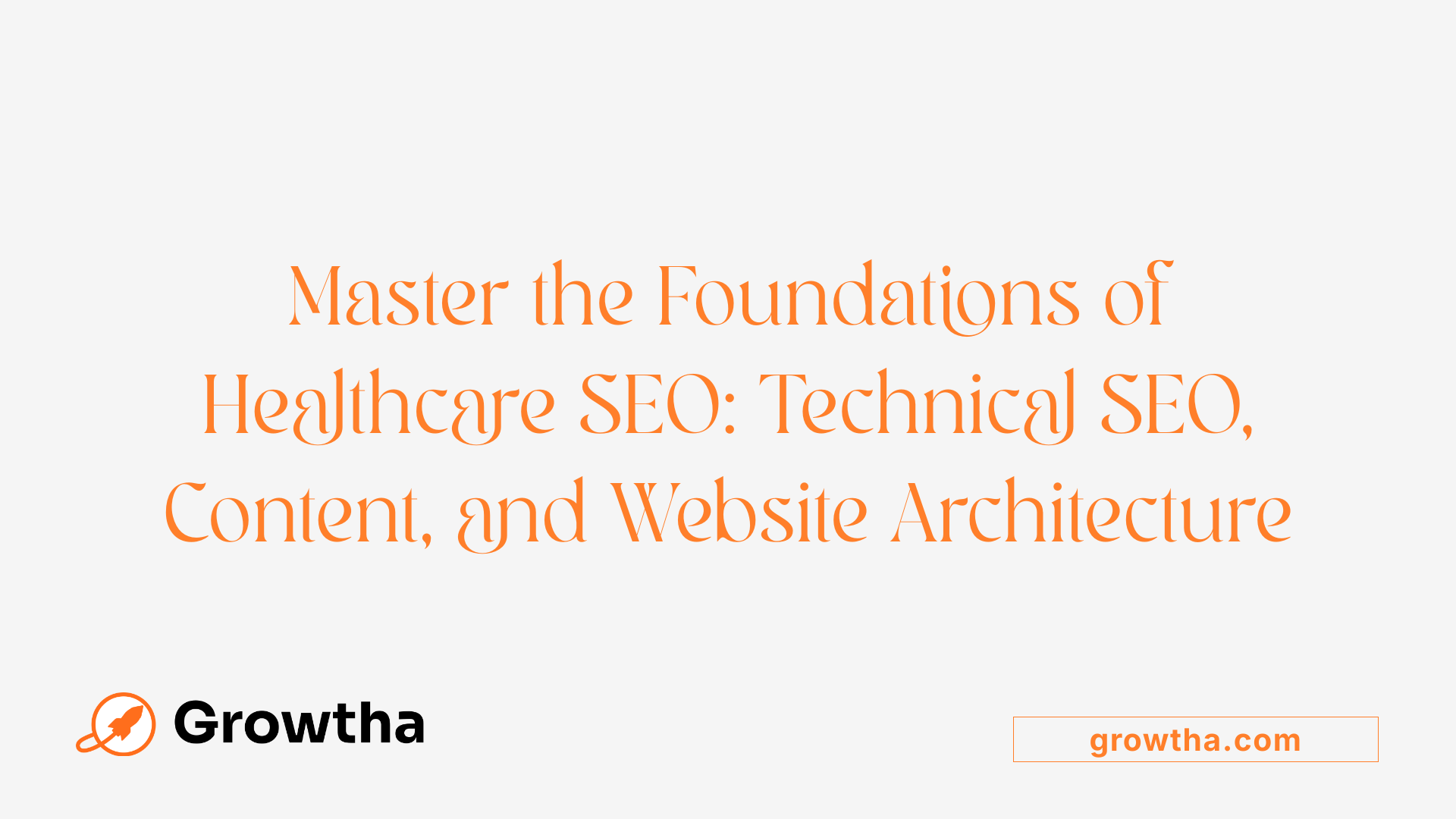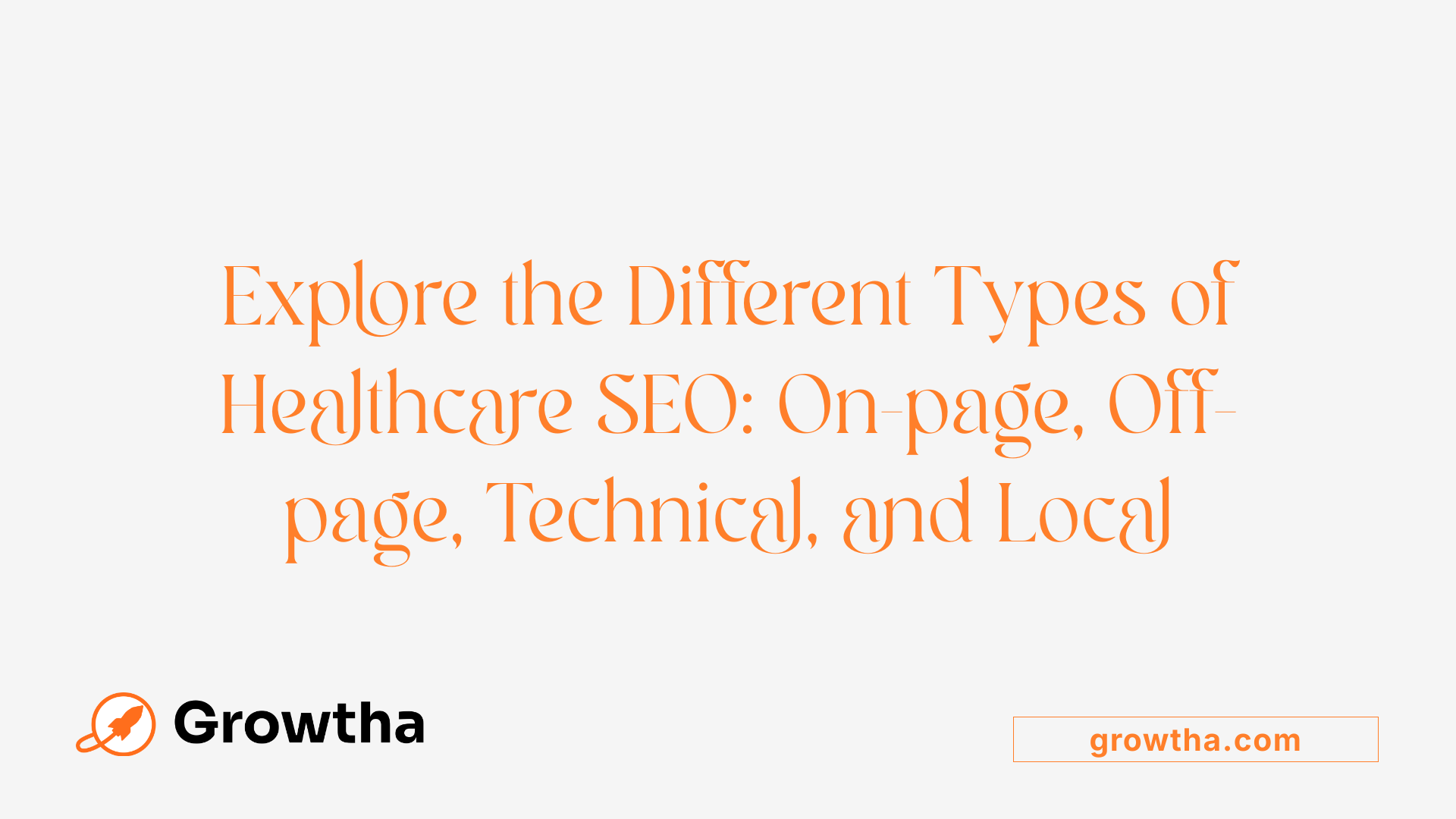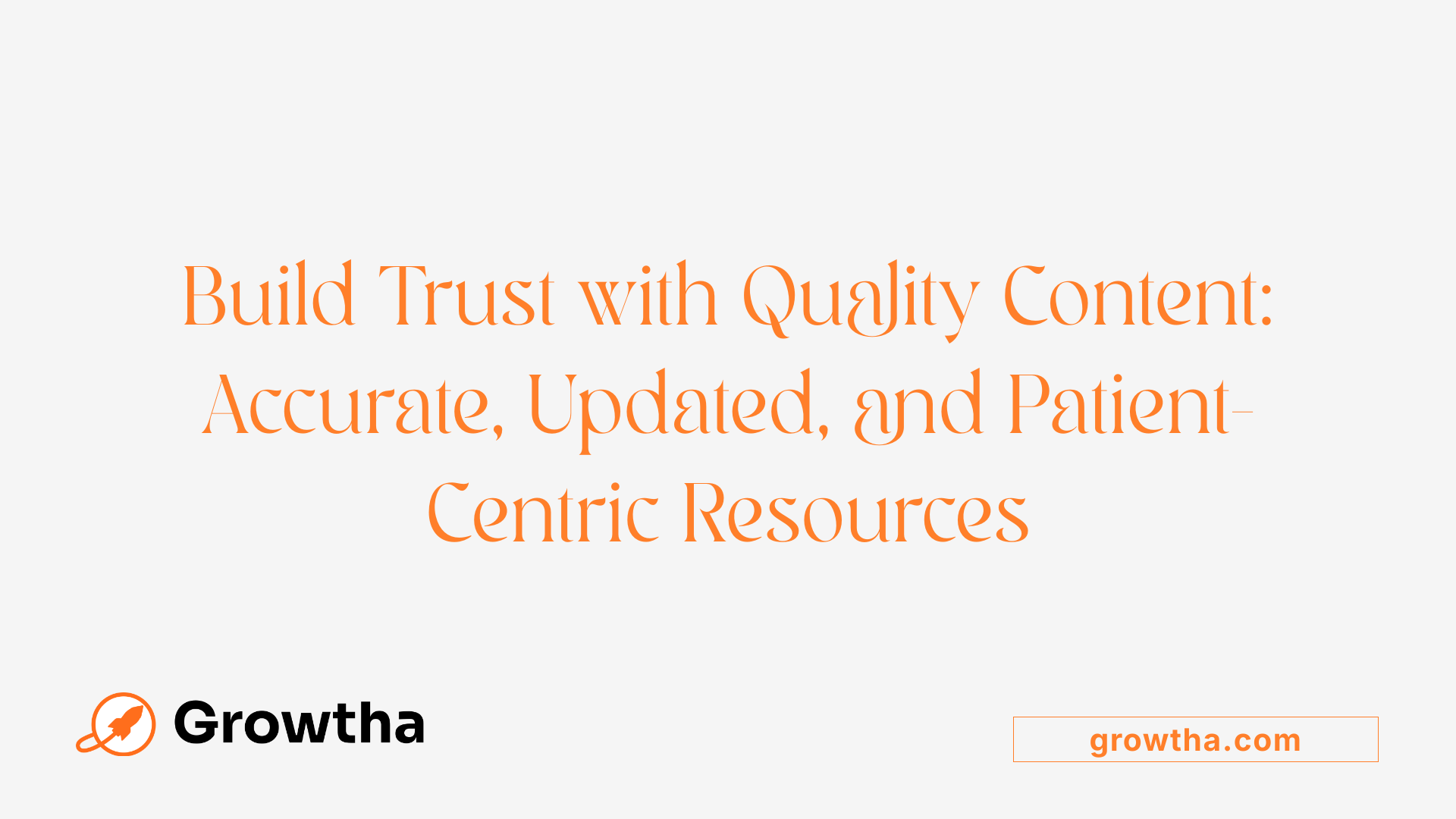SEO for Hospitals and Large Healthcare Groups
Unlocking Online Success for Healthcare Organizations


SEO for Hospitals and Large Healthcare Groups
The Critical Role of SEO in Healthcare Visibility
In today’s digital age, hospitals and large healthcare groups rely heavily on search engine optimization (SEO) to attract new patients, improve reputation, and stay competitive. With over 90% of health-related queries starting with a search engine, optimizing your healthcare website for maximum visibility is no longer optional—it is essential. This article explores how SEO can be strategically employed in the healthcare sector, covering fundamental practices, industry-specific challenges, local strategies, and emerging trends to ensure your organization stays at the top of search results.
The Role of SEO in Healthcare

How is SEO used in healthcare?
Healthcare SEO focuses on optimizing medical websites to increase their visibility in search engine results, especially Google, which dominates the search market. It involves a combination of strategies such as keyword research, content creation, technical optimization, and local SEO. Medical practices aim to appear at the top when potential patients search for health-related terms, conditions, or provider services.
To achieve this, healthcare websites must produce high-quality, accurate content that addresses patient questions and builds trust. This includes optimized titles, meta descriptions, headers, and schema markup, along with ensuring fast load times and mobile responsiveness. By claiming and optimizing local listings like Google My Business, providers can also boost their presence in local searches, helping patients find nearby clinics or doctors.
Effective SEO in healthcare not only increases online visibility but also fosters credibility by demonstrating expertise, experience, and trustworthiness—principles emphasized by Google’s E-E-A-T standards. This ongoing process attracts targeted traffic, generates measurable results through analytics, and ultimately helps practices grow their patient base and competitive edge.
Building trust through accurate content
Trustworthiness is crucial in healthcare SEO. Search engines prioritize sites that provide reliable, well-reviewed, and ethical information, especially given the privacy and safety implications. Content must be authored or reviewed by qualified medical professionals, ensuring accuracy and compliance with regulations like HIPAA.
High-quality content includes detailed 'About us' pages, service descriptions, FAQs, blogs, and patient education resources. Transparency about privacy policies, contact information, and credentials enhances credibility. Using rich media such as videos and images with descriptive alt tags further boosts user engagement and SEO rankings.
To foster trust further, healthcare providers should encourage patient reviews on platforms like Google, responding promptly and professionally to feedback to demonstrate patient engagement and satisfaction.
Measuring ROI in healthcare SEO
Evaluating the success of healthcare SEO efforts involves tracking various metrics. Search rankings for targeted keywords, organic traffic, click-through rates, and bounce rates reveal visibility and engagement levels. Tools such as Google Search Console, Google Analytics, and specialized SEO platforms help monitor these indicators.
Conversion tracking—measuring how many visitors schedule appointments or contact the practice—is essential to understand ROI. Comparing performance against competitors and industry benchmarks highlights areas for improvement.
Ongoing optimization based on insights from analytics ensures sustained growth and visibility. As Google updates its algorithms, maintaining a solid SEO foundation with fresh, authoritative content, technical health, and local engagement remains vital for long-term success.
Core Components of Healthcare SEO

What are the four pillars of SEO strategy?
Understanding the foundations of effective healthcare SEO begins with recognizing the four major components: technical SEO, on-page SEO, content, and off-page SEO.
Technical SEO forms the backbone of your website’s ability to be crawled and indexed by search engines. This involves optimizing site speed, ensuring your site is mobile-responsive, setting up an XML sitemap, and fixing crawl errors. Proper site architecture, like siloing related content, ensures that search engines and users find information easily, which boosts rankings.
On-page SEO targets the optimization of individual web pages. This includes crafting compelling meta titles and descriptions, utilizing appropriate header tags (H1, H2), and integrating structured data markup to enhance search listings. Internal linking and insightful URL structures help search engines understand your site hierarchy.
Content is at the heart of healthcare SEO. High-quality, accurate, and relevant articles and resources build topical authority. It is essential to perform keyword research to discover the most relevant health-related terms, including long-tail keywords and local search phrases. Content should reflect expertise and answer patient questions effectively.
Off-page SEO involves building credibility outside your website. This includes earning backlinks from reputable healthcare sources, maintaining consistent NAP information, managing online reviews, and engaging with the community through social media. These efforts extend your website’s authority and improve rankings.
Within these pillars, the focus on secure sites using HTTPS, accessibility standards, and local SEO optimization ensures comprehensive coverage to reach and serve patients effectively.
How does website architecture facilitate growth?
A well-structured website allows both users and search engines to navigate easily. Practices such as siloing related content into thematic groups help search engines crawl your site more efficiently and understand the relevance of your pages. Clear menus and internal links keep visitors engaged and guide them to the information they seek.
By organizing content around specific health topics and services, healthcare providers can target more keywords and improve relevance in search results. This strategic setup supports ongoing content expansion and improves overall SEO performance.
What are the essential aspects of content optimization for health topics?
Optimizing healthcare content involves thorough keyword research to match the language patients use when searching for health information. Incorporating target keywords naturally into titles, headers, and body text makes content discoverable.
Meta descriptions, alt tags for images, and structured headers improve visibility and accessibility. Content must be regularly updated to stay current and relevant, which helps maintain and enhance SEO rankings.
High-quality, authoritative content not only attracts visitors but also encourages sharing and backlinks, which are vital for building authority. Ensuring all content complies with healthcare regulations and emphasizes trustworthiness enhances both reputation and search engine performance.
| Aspect | Focus Area | Details |
|---|---|---|
| Keyword research | Content creation | Find relevant health keywords, including local and long-tail |
| Technical SEO | Site structure | Enable fast loading, mobile-friendliness, and structured data |
| Website architecture | Growth facilitation | Use siloing, thematic grouping, and straightforward navigation |
| Content optimization | Health topics | Use natural keywords, optimize metadata, and ensure authoritative accuracy |
Types of SEO Relevant to Healthcare
 Understanding the different types of SEO is fundamental for healthcare organizations aiming to improve their online visibility. These categories focus on specific aspects of website optimization to ensure hospitals, clinics, and health providers can attract and retain patients effectively.
Understanding the different types of SEO is fundamental for healthcare organizations aiming to improve their online visibility. These categories focus on specific aspects of website optimization to ensure hospitals, clinics, and health providers can attract and retain patients effectively.
What are four types of SEO?
There are several modes of SEO, each addressing different needs. The primary types include:
On-Page SEO: This involves optimizing all elements on a website, such as content, title tags, meta descriptions, headers, images, and internal links. For healthcare providers, on-page SEO ensures that relevant medical information, symptom guides, and doctor bios are optimized with targeted keywords to meet patient search intent.
Off-Page SEO: This refers to building the website’s authority through external means like backlinks from reputable health sources, online reviews, and social media engagement. Strong backlinks from trusted medical organizations can significantly boost rankings.
Technical SEO: Technical health ensures the site is easy for search engines to crawl and index. Important practices include improving site load speed (aiming for under 2 seconds), ensuring mobile responsiveness, securing the site with HTTPS, and utilizing structured data and schema markups relevant to healthcare.
Local SEO: For healthcare providers, especially those with physical locations, local SEO is crucial. It involves optimizing Google My Business profiles, managing local citations, and generating patient reviews to appear prominently in local searches like “urgent care near me” or “pediatrician in [city].”
Alongside these core types, specialized SEO strategies like international SEO for multi-region sites, voice search optimization for patient queries, and content marketing tailored to specific health conditions are gaining importance.
Why do these types matter?
Combining these SEO strategies allows healthcare websites to appear at the top of relevant search results, attract targeted local traffic, and establish authority in the medical field. Regularly updating content, maintaining technical health, and engaging with the local community further enhance online presence, patient trust, and organizational growth.
| SEO Type | Focus Area | Benefits | Examples |
|---|---|---|---|
| On-Page SEO | Website content, meta tags, headers | Improves relevance and ranking for patient queries | Optimized article pages, doctor bios |
| Off-Page SEO | Backlinks, reviews, external authority | Boosts site trustworthiness and domain authority | Healthcare blog backlinks, reviews |
| Technical SEO | Site speed, structured data, security, crawlability | Ensures website is accessible and preferable to search engines | HTTPS, schema for medical data |
| Local SEO | Google My Business, local citations, review management | Improves local visibility and patient inquiries | Local clinic profiles, citations |
Optimizing across all these SEO types provides a comprehensive approach to enhancing healthcare online presence, ensuring both patients and search engines find your services easy to discover.
Cost of Healthcare SEO
How much does healthcare SEO cost?
Healthcare SEO expenses can vary greatly depending on several factors such as the size of the organization, competitiveness of the local market, and the scope of services needed. Typically, smaller practices or local providers may allocate between $300 and $2,000 per month for SEO efforts. In contrast, larger hospitals or healthcare networks operating in highly competitive areas might spend from $5,000 up to $30,000 or more monthly.
There are different pricing models available to suit different healthcare organizations. Monthly retainers often range from $1,500 to $5,000. Some providers opt for hourly rates, which generally fall between $100 and $300. For comprehensive campaigns covering all aspects of SEO, project-based fees can reach up to $30,000.
Various factors influence the costs involved, including the experience of the SEO agency, the overall goals, and the geographic location of the healthcare provider. Budget planning should consider these variables to ensure the investment aligns with expected outcomes.
Investing in healthcare SEO can yield substantial return on investment (ROI) through increased online visibility, more patient inquiries, and higher appointment bookings. While initial costs might seem significant, the long-term benefits include sustained organic traffic and improved credibility within the community.
In summary, healthcare SEO costs are highly adaptable and should be tailored to meet the specific needs of the provider, balancing budget constraints with strategic objectives.
Industry Regulations and Ethical Standards

How much does healthcare SEO cost?
Healthcare SEO costs can vary significantly based on factors such as the scope of services, the size of the healthcare organization, and the level of competition. Typically, smaller practices or local providers may allocate between $300 and $2,000 each month for SEO services. Larger hospitals or healthcare systems with extensive target markets and more competitive sectors might spend $5,000 to $30,000 or more per month.
Pricing models are diverse, with common options including monthly retainers ranging from $1,500 to $5,000, hourly rates from $100 to $300, or project-based fees that could reach $30,000 for comprehensive campaigns. The variance is influenced by agency experience, specific goals, geographic location, and service complexity. A tailored SEO strategy aligned with budget and objectives ensures optimal performance and results.
Understanding these costs helps healthcare providers plan their marketing budgets effectively and choose the right partners to enhance their online visibility without compromising compliance and ethical standards.
Technical SEO for Healthcare Websites
How much does healthcare SEO cost?
Healthcare SEO pricing varies based on the size of the practice, competition level, and scope of services. Small local practices typically spend between $300 and $2,000 per month, focusing on essential local SEO and content updates. Larger healthcare organizations with broader needs might invest $5,000 to $30,000 or more each month, especially if they require extensive website optimization, ongoing content creation, and backlink building.
Pricing models can include monthly retainers, hourly rates, and project-based fees. Monthly retainers generally range from $1,500 to $5,000, while hourly SEO specialists charge between $100 and $300. For comprehensive campaigns, flat project fees can reach up to $30,000.
Factors influencing costs include the agency’s experience, the complexity of website architecture, competitive landscape, and specific goals like local search dominance or national visibility. Tailoring the investment to the practice's needs ensures effective results without overspending.
Overall, healthcare SEO expenses are highly adaptable and should align with strategic objectives to maximize return on investment.
Content Strategy and Patient Trust

How much does healthcare SEO cost?
Healthcare SEO expenses can vary greatly based on several factors such as the size of the practice, the competitiveness of the market, and the scope of services needed. Small clinics or local practices might spend between $300 and $2,000 per month on SEO efforts. Larger hospitals or organizations in highly competitive areas could invest from $5,000 to $30,000 or more monthly.
Pricing models range from monthly retainers, which typically cost between $1,500 and $5,000, to hourly rates that can be between $100 and $300. Some providers opt for project-based billing, which may reach up to $30,000 for comprehensive campaigns.
Overall, the cost of healthcare SEO is highly adaptable and should be aligned with specific organizational goals, target audiences, and available budgets. Tailoring SEO efforts ensures maximum ROI and effective online visibility.
Reviewing and updating medical content
Regularly reviewing and updating medical information on healthcare websites is essential to maintain accuracy, relevance, and trustworthiness. Credible healthcare organizations ensure their content reflects current research, guidelines, and medical standards. This ongoing process helps prevent the spread of outdated or incorrect information, which could harm patient trust and compromise compliance.
Updated content also signals to search engines that the site is active and authoritative, positively impacting rankings. Incorporating the latest medical research, industry news, and treatment options enhances overall content quality.
Creating patient-centric resources
Providing patient-focused resources is a cornerstone of effective healthcare content strategies. Resources such as FAQs, condition guides, symptom checkers, and educational videos help patients make informed decisions. These materials should be easy to understand, accessible, and tailored to diverse literacy levels.
Patient-centric content fosters trust, encourages engagement, and improves the user experience. Using plain language and addressing common questions makes the website more helpful and authoritative. Effective content also guides patients toward desired actions, such as scheduling appointments or contacting providers.
Building authority with credible authorship
Establishing authority involves featuring expert authorship. Content authored or reviewed by qualified medical professionals, such as physicians and specialists, demonstrates credibility. Including detailed bios, credentials, and professional experience enhances trustworthiness.
Transparent authorship is especially important in healthcare due to the high stakes involved. Google’s E-E-A-T principles emphasize that authoritative, well-sourced content ranks higher in search results. Therefore, credentialed authorship not only boosts rankings but also reassures patients of the information’s reliability.
Effective healthcare content combines ongoing updates, patient-centered resources, and authoritative authorship to build stronger relationships with visitors and improve overall SEO performance.
Measuring and Monitoring SEO Performance
To gauge the effectiveness of healthcare SEO strategies, utilizing advanced tools like Google Search Console and Google Analytics is essential. These platforms provide valuable insights into how your website is performing in search results, including traffic sources, user behavior, and technical issues that may impact visibility.
Tracking keyword rankings and organic traffic helps healthcare providers understand which search terms drive visitors to their site and how well their content resonates with the target audience. Regularly monitoring these metrics allows for timely adjustments to optimize ranking positions and attract more relevant visitors.
Benchmarking against competitors offers a perspective on industry positioning. By analyzing competitors' SEO performance, including their keyword strategies, backlink profiles, and content quality, healthcare organizations can identify gaps and opportunities for improvement.
Below is a summary of important performance metrics and tools:
| Metric | Tool/Method | Purpose |
|---|---|---|
| Search Rankings | Google Search Console, SEMrush | Track and improve keyword positions |
| Organic Traffic | Google Analytics | Measure visitors coming from search engines |
| Backlink Profile | Ahrefs, Moz | Assess domain authority and link quality |
| Competitor Analysis | SEMrush, SimilarWeb | Understand industry benchmarks and strategies |
| Performance Dashboards | Data Studio, custom dashboards | Visualize data for ongoing optimization |
Regarding cost, healthcare SEO costs can vary. Most practices spend between $400 and $10,000 per month. Smaller clinics often allocate $300 to $2,000 monthly, while larger organizations might invest $5,000 to $30,000 or more. The approach depends on goals, scope, location, and agency experience, with various pricing models available such as monthly retainers, hourly rates, and project-based fees.
Tracking and benchmarking are ongoing processes that help ensure your healthcare website maintains high visibility and attracts the right patient audience. Regular analysis allows healthcare providers to adapt their SEO strategies to changing algorithms, industry trends, and competitive landscapes.
Emerging Trends and Future of Healthcare SEO
What are four types of SEO?
There are several types of SEO, each focusing on different aspects of optimizing a website for search engines. The main types include On-Page SEO, which involves optimizing website content, meta tags, and site structure; Off-Page SEO, which focuses on building backlinks and improving external authority; Technical SEO, which ensures the website is crawlable, fast, mobile-friendly, and technically sound; and Local SEO, which targets geographically relevant searches to attract nearby customers. Additionally, there are specialized types like E-commerce SEO for online stores, YouTube SEO for video content, International SEO for multi-region sites, Mobile SEO for improved mobile performance, and Voice SEO optimized for voice search queries. Together, these various SEO strategies are essential for enhancing overall visibility, increasing organic traffic, and providing a seamless user experience tailored to search intent.
AI and machine learning applications
The future of healthcare SEO is increasingly shaped by artificial intelligence (AI) and machine learning algorithms. These technologies enable search engines to better understand search intent, evaluate content quality based on E-E-A-T principles, and deliver highly personalized results. Healthcare providers can leverage AI tools for keyword research, content optimization, and analyzing user behavior to improve engagement. AI-powered chatbots also offer immediate patient support, align with SEO efforts by providing relevant information, and enhance user experience. As AI continues to evolve, healthcare websites will benefit from more precise targeting, automated content updates, and smarter SEO tools.
Voice search optimization
With the rapid growth of voice-activated devices and virtual assistants, voice search has become a critical facet of healthcare SEO. Patients often ask health-related questions verbally, emphasizing the need for natural language keywords and conversational content. Optimizing for voice search involves creating FAQs, using long-tail keywords, and structuring content with schema markup to improve search snippets. Healthcare providers should aim for quick, direct answers to common patient queries to capture voice traffic. As voice searches are contextually sensitive and prevalent among elderly and disabled populations, integrating voice optimization strategies will significantly boost local search visibility and patient engagement.
Personalized content and patient engagement
Personalization is emerging as a vital component in healthcare SEO. By analyzing user data, preferences, and search patterns, healthcare websites can deliver customized content tailored to individual patient needs. Personalized content increases relevance, builds trust, and encourages patient retention. Techniques include dynamic web pages, targeted blog topics, and tailored recommendations based on diagnoses or demographics. Engaged patients are more likely to book appointments and share positive reviews, further supporting local SEO efforts. Future advancements in data analytics and AI will make personalized healthcare content more sophisticated, offering real-time updates and interactive patient education pathways.
Compliance and privacy considerations
As healthcare SEO advances, maintaining compliance with regulations like HIPAA and protecting patient privacy remain paramount. Search engines favor websites that demonstrate transparency and trustworthy data practices. Ensuring HTTPS security, regularly updating privacy policies, and avoiding the sharing of personal health information are essential. Structured data markup must also be used responsibly, avoiding any misrepresentation of sensitive info. Healthcare providers should stay informed about evolving privacy laws and implement robust cybersecurity measures. Balancing innovative SEO strategies with ethical and legal standards will be crucial to sustain trust, improve search rankings, and avoid legal repercussions.
| Aspect | Focus Area | Importance | Future Outlook |
|---|---|---|---|
| AI & Machine Learning | Content optimization, personalization, search intent | Enhance relevance and automation | Increased integration into SEO tools, smarter algorithms |
| Voice Search | Natural language, FAQs, schema markup | Capture spoken health queries | Dominance in local and immediate response searches |
| Personalized Content | Dynamic updates, patient data analysis | Improve user engagement and trust | More sophisticated targeting, real-time updates |
| Privacy & Compliance | HTTPS, privacy policies, lawful data use | Maintain trust and legal compliance | Greater regulation adherence, advanced security measures |
Staying ahead in healthcare SEO involves embracing these emerging trends while maintaining a focus on compliance, accuracy, and user trust. As technology advances, healthcare organizations that adapt will enjoy better visibility, higher patient engagement, and a stronger reputation online.
Building a Trusted Healthcare Website
How is SEO used in healthcare?
Healthcare SEO is a specialized strategy aimed at increasing the visibility of medical websites on search engines like Google, Bing, and DuckDuckGo. Since most patients turn to online searches before choosing healthcare providers, optimizing a website’s content, structure, and local presence is crucial.
Effective healthcare SEO involves keyword research tailored to patient queries, comprehensive content creation, and technical optimizations like fast load times and mobile responsiveness. It also emphasizes the importance of local SEO through Google My Business profiles, local keywords, and managing online reviews.
By ensuring content is accurate, authoritative, and aligned with search intent, healthcare providers can build credibility and trust with prospective patients. This process also involves complying with legal standards such as HIPAA, maintaining website security with HTTPS, and showcasing credentials through transparent policies and professional bios.
Overall, healthcare SEO is an ongoing investment that helps practices attract targeted visitors, improve reputation, and generate measurable results, such as increased appointment bookings and improved search rankings.
Harnessing SEO for Healthcare Success
Implementing a comprehensive SEO strategy tailored to healthcare needs is vital for hospitals and large healthcare groups to thrive in an increasingly digital landscape. From technical infrastructure and local SEO to authoritative content and compliance, every aspect plays a role in building trust, boosting online visibility, and attracting new patients. Staying ahead of emerging trends such as AI, voice search, and personalized content will ensure your healthcare organization remains competitive and responsive to patient needs. By investing in ongoing monitoring, adhering to regulatory standards, and focusing on high-quality patient-centric content, healthcare providers can leverage SEO as a powerful long-term asset for growth and reputation enhancement.
References
- Healthcare SEO: 5-Step Medical SEO Guide for Beginners
- The Ultimate Guide to Healthcare SEO: 3 Techniques Your Website ...
- Healthcare SEO: how to improve your organic performance
- SEO for Healthcare - Geonetric
- Healthcare SEO: Complete Industry Guide for 2025
- Is Healthcare SEO Really Worth the Investment? | Net Health
- Why Is SEO for Healthcare Websites Important? - TBH Creative Blog







